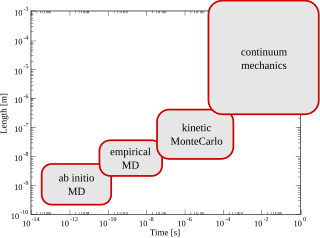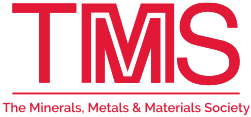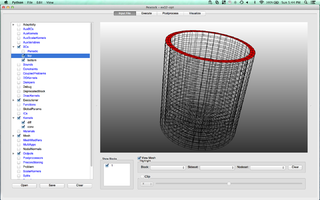United States federal research funders use the term cyberinfrastructure to describe research environments that support advanced data acquisition, data storage, data management, data integration, data mining, data visualization and other computing and information processing services distributed over the Internet beyond the scope of a single institution. In scientific usage, cyberinfrastructure is a technological and sociological solution to the problem of efficiently connecting laboratories, data, computers, and people with the goal of enabling derivation of novel scientific theories and knowledge.

Microstructure is the very small scale structure of a material, defined as the structure of a prepared surface of material as revealed by an optical microscope above 25× magnification. The microstructure of a material can strongly influence physical properties such as strength, toughness, ductility, hardness, corrosion resistance, high/low temperature behaviour or wear resistance. These properties in turn govern the application of these materials in industrial practice.

Markus J. Buehler is an American materials scientist and engineer at the Massachusetts Institute of Technology (MIT), where he holds the endowed McAfee Professorship of Engineering chair. He is a member of the faculty at MIT's Department of Civil and Environmental Engineering, where he directs the Laboratory for Atomistic and Molecular Mechanics (LAMM), and also a member of MIT's Center for Computational Science and Engineering (CCSE) in the Schwarzman College of Computing. His scholarship spans science to art, and he is also a composer of experimental, classical and electronic music, with an interest in sonification. He has given several TED talks about his work.

Multiscale modeling or multiscale mathematics is the field of solving problems that have important features at multiple scales of time and/or space. Important problems include multiscale modeling of fluids, solids, polymers, proteins, nucleic acids as well as various physical and chemical phenomena.

The Minerals, Metals & Materials Society (TMS) is a professional organization for materials scientists and engineers that encompasses the entire range of materials and engineering, from minerals processing and primary metals production to basic research and the advanced applications of materials.

In the theory of composite materials, the representative elementary volume (REV) is the smallest volume over which a measurement can be made that will yield a value representative of the whole. In the case of periodic materials, one simply chooses a periodic unit cell, but in random media, the situation is much more complicated. For volumes smaller than the RVE, a representative property cannot be defined and the continuum description of the material involves Statistical Volume Element (SVE) and random fields. The property of interest can include mechanical properties such as elastic moduli, hydrogeological properties, electromagnetic properties, thermal properties, and other averaged quantities that are used to describe physical systems.
Market engineering comprises the structured, systematic and theoretically founded procedure of analyzing, designing, introducing and also quality assuring of markets as well as their legal framework regarding simultaneously their market mechanisms and trading rules, systems, platforms and media, and their business models. In this context, term market stands for a set of rules defining the exchange of information between participants to conduct transactions at minimized cost. Market Engineering borrows concepts and methods from Economics, particularly, Game Theory, and Mechanism Design concepts, but also borrows concepts from Finance, Information Systems and Operations Research. It finds particular application in the context of electronic market platforms.
A phase-field model is a mathematical model for solving interfacial problems. It has mainly been applied to solidification dynamics, but it has also been applied to other situations such as viscous fingering, fracture mechanics, hydrogen embrittlement, and vesicle dynamics.

nanoHUB.org is a science and engineering gateway comprising community-contributed resources and geared toward education, professional networking, and interactive simulation tools for nanotechnology. Funded by the United States National Science Foundation (NSF), it is a product of the Network for Computational Nanotechnology (NCN). NCN supports research efforts in nanoelectronics; nanomaterials; nanoelectromechanical systems (NEMS); nanofluidics; nanomedicine, nanobiology; and nanophotonics.
In machining, vibrations, also called chatter, are the relative movements between the workpiece and the cutting tool. The vibrations result in waves on the machined surface. This affects typical machining processes, such as turning, milling and drilling, and atypical machining processes, such as grinding.
The Center for Simulation of Advanced Rockets (CSAR) is an interdisciplinary research group at the University of Illinois at Urbana-Champaign, and is part of the United States Department of Energy's Advanced Simulation and Computing Program. CSAR's goal is to accurately predict the performance, reliability, and safety of solid propellant rockets.
Integrated computational materials engineering (ICME) involves the integration of experimental results, design models, simulations, and other computational data related to a variety of materials used in multiscale engineering and design. Central to the achievement of ICME goals has been the creation of a cyberinfrastructure, a Web-based, collaborative platform which provides the ability to accumulate, organize and disseminate knowledge pertaining to materials science and engineering to facilitate this information being broadly utilized, enhanced, and expanded.
R. Edwin Garcia is a Professor of Materials Engineering at Purdue University. Garcia's research group focuses on the design of materials and devices through the development of a fundamental understanding of the solid state physics of the individual phases, their short and long range interactions, and its associated microstructural evolution.

MOOSE is an object-oriented C++ finite element framework for the development of tightly coupled multiphysics solvers from Idaho National Laboratory. MOOSE makes use of the PETSc non-linear solver package and libmesh to provide the finite element discretization.
Mark F. Horstemeyer is the Dean of the School of Engineering at Liberty University. He was the Giles Distinguished Professor at Mississippi State University (MSU) and professor in the Mechanical Engineering Department at Mississippi State University (2002–2018), holding a Chair position for the Center for Advanced Vehicular Systems (CAVS) in Computational Solid Mechanics; he was also the Chief Technical Officer for CAVS. Before coming to MSU, he worked for Sandia National Laboratories for fifteen years (1987-2002) in the area of multiscale modeling for design.
Design for additive manufacturing is design for manufacturability as applied to additive manufacturing (AM). It is a general type of design methods or tools whereby functional performance and/or other key product life-cycle considerations such as manufacturability, reliability, and cost can be optimized subjected to the capabilities of additive manufacturing technologies.
Computational materials science and engineering uses modeling, simulation, theory, and informatics to understand materials. The main goals include discovering new materials, determining material behavior and mechanisms, explaining experiments, and exploring materials theories. It is analogous to computational chemistry and computational biology as an increasingly important subfield of materials science.
The Open Knowledgebase of Interatomic Models (OpenKIM). is a cyberinfrastructure funded by the United States National Science Foundation (NSF) focused on improving the reliability and reproducibility of molecular and multi-scale simulations in computational materials science. It includes a repository of interatomic potentials that are exhaustively tested with user-developed integrity tests, tools to help select among existing potentials and develop new ones, extensive metadata on potentials and their developers, and standard integration methods for using interatomic potentials in major simulation codes. OpenKIM is a member of DataCite and provides unique DOIs (Digital object identifier) for all archived content on the site (fitted models, validation tests, etc.) in order to properly document and provide recognition to content contributors. OpenKIM is also an eXtreme Science and Engineering Discovery Environment (XSEDE) Science Gateway, and all content on openkim.org is available under open source licenses in support of the open science initiative.

Somnath Ghosh is the Michael G. Callas Chair Professor in the Department of Civil & Systems Engineering and a Professor of Mechanical Engineering and Materials Science & Engineering at Johns Hopkins University (JHU). He is the founding director of the JHU Center for Integrated Structure-Materials Modeling and Simulation (CISMMS) and was the director of an Air Force Center of Excellence in Integrated Materials Modeling (CEIMM). Prior to his appointment at JHU, Ghosh was the John B. Nordholt Professor of Mechanical Engineering and Materials Science & Engineering at Ohio State University. He is a fellow of several professional societies, including the American Association for the Advancement of Science (AAAS).








